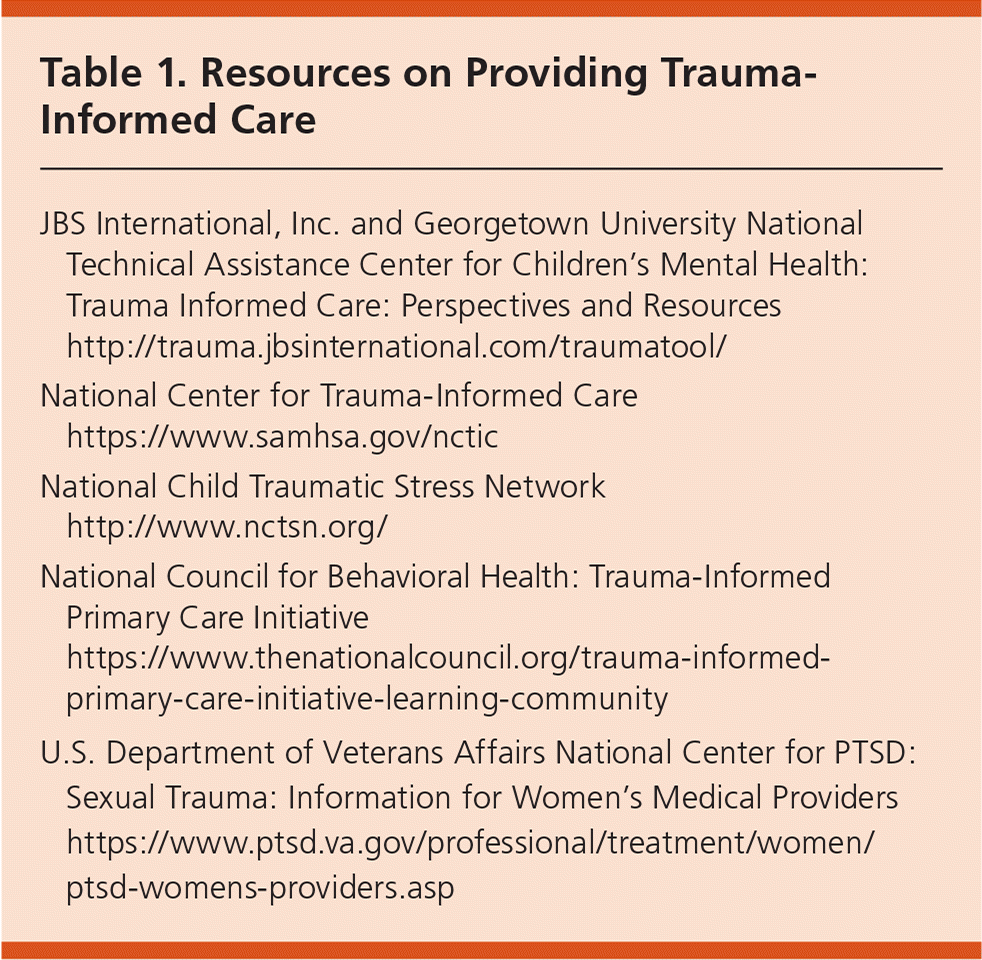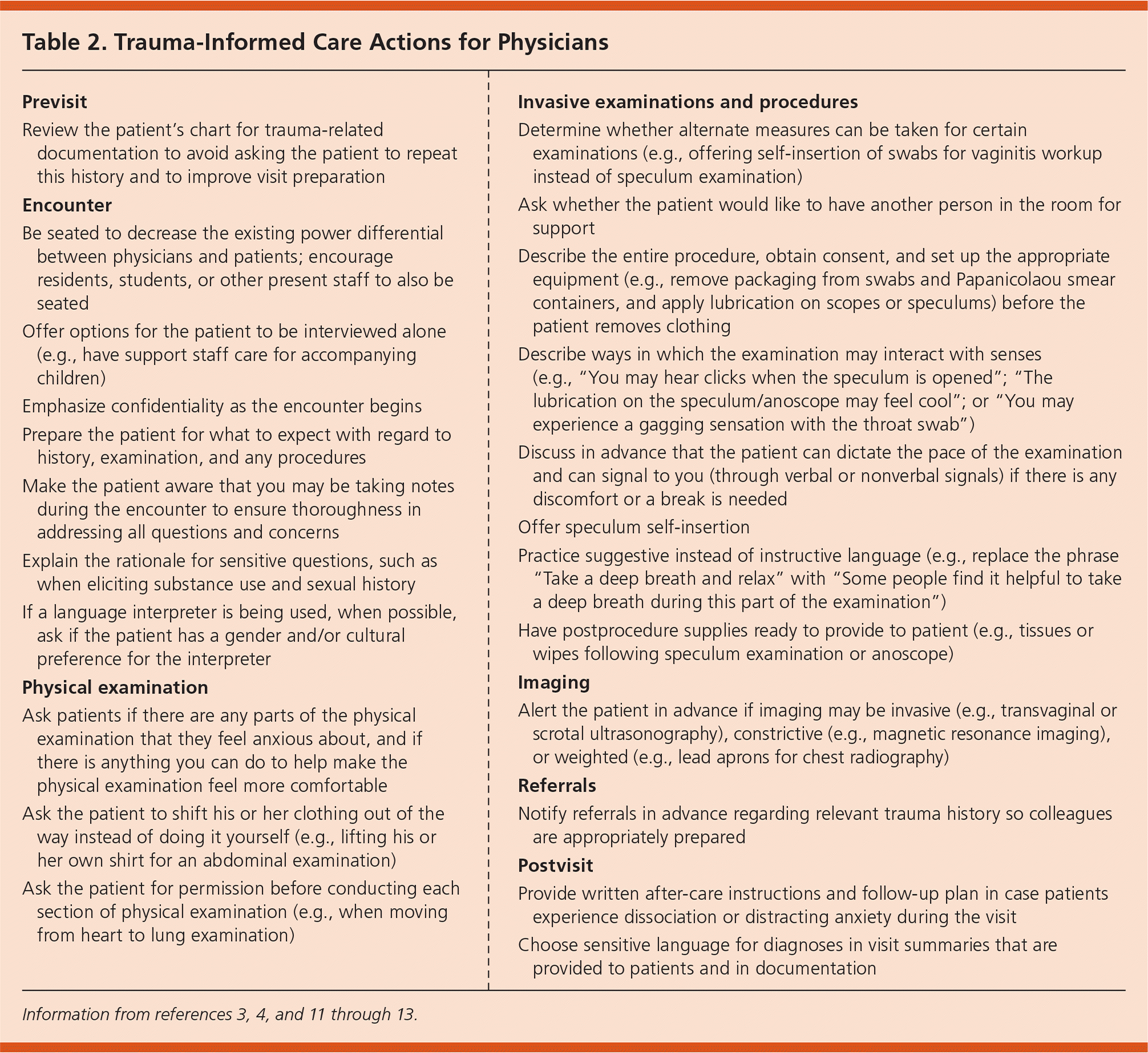
Am Fam Physician. 2017;95(10):655-657
Author disclosure: No relevant financial affiliations.
Case Scenario
A 52-year-old woman who is a patient at our group practice made a walk-in visit to our clinic for treatment of bothersome vaginal discharge. She was accompanied by her five-year-old grandchild. I was covering for her primary care physician, and this was my first time meeting this patient. I offered to perform a speculum examination to address her vaginal discharge and to complete a Papanicolaou (Pap) smear because cervical cancer screening was not documented in her chart. However, she declined a speculum examination, stating, “I don’t really do those.” She was otherwise engaged in conversation, and remarked that the demands of her job as an administrator have caused her to miss many appointments. My colleague later informed me that the patient had experienced significant sexual trauma in her past and does not feel comfortable with speculum-based examinations. How could I have sensitively addressed this patient’s health care needs?
Commentary
Family physicians commonly care for survivors of trauma, but they may not always realize it. Trauma, which can affect any patient regardless of age or sex, is broadly defined as the experience of violence or victimization, including sexual abuse, physical abuse, psychological abuse, neglect, loss, domestic violence or the witnessing of violence, and terrorism or disasters.1 Survivors of trauma experience poorer health outcomes, including onset of chronic medical and mental health conditions, at a higher rate than those who have not experienced trauma.2 Furthermore, shame and stigma may prevent survivors from disclosing their trauma histories during clinical encounters.3 For these reasons, it is important to incorporate trauma-informed care into practice as a universal precaution to optimally address patients’ health care needs while decreasing the risk of retraumatization.4 The core principles of this care include the four R’s: (1) realizing the widespread impact of trauma; (2) recognizing signs and symptoms of trauma, including in patients and their families and in staff and clinical team members; (3) responding by fully integrating knowledge about trauma into policies, procedures, and practices; and (4) seeking to actively resist retraumatization.5
SIGNS AND SYMPTOMS
Clinicians may find it challenging to identify patients who have experienced trauma. Signs and symptoms can vary depending on the type, frequency, or duration of trauma and the time elapsed since trauma was experienced. Clinical presentations may include vague, generalized symptoms, such as abdominal or pelvic discomfort, sexual dysfunction, headaches, or chronic pain, and mental health symptoms that suggest depression, anxiety, or posttraumatic stress disorder.3,6 Certain behaviors can also serve as coping mechanisms for these trauma-related symptoms, including smoking, alcohol and drug use, disordered eating, and high-risk sexual behaviors.4 Some persons may have a higher likelihood of experiencing trauma, including those who are entangled with the legal system and persons with a disability, as well as refugees, veterans, or those who identify as lesbian, gay, bisexual, transgender, or queer.6–9 More broadly, inconsistent patterns of clinical care, such as multiple missed appointments or missed health maintenance examinations or interventions, may also be associated with trauma-related behaviors. Fear of retraumatization can limit survivors’ use of health care services to emergency and acute care visits and lead to avoidance of routine primary care.6
APPROACH TO CARE
When trauma is suspected, multiple techniques can be useful for approaching the topic with a patient.10 First, it is important to create an environment where patients can feel comfortable disclosing trauma. For example, in scenarios such as this one, it may be helpful to ask support staff if they are available to assist with child care during a portion of the caregiver’s visit. Emphasizing confidentiality and using prompts that are normalizing or provide rationale for inquiry into past trauma may also be helpful. The clinician could begin this discussion by saying, “Because abuse and violence are common and can affect a person’s health, I make a point to ask patients if they have ever had these experiences.” It is important that clinicians be prepared to effectively respond to potential disclosure. This includes providing empathetic responses during the encounter and adequate care afterwards (e.g., by identifying resources or scheduling a follow-up appointment, if the patient desires). Survivors have expressed a range of preferences in how they wish to be asked about trauma, including being asked directly or indirectly about these experiences. Resources on trauma-informed approaches, including how to discuss the topic of trauma with patients, are listed in Table 1.

| JBS International, Inc. and Georgetown University National Technical Assistance Center for Children’s Mental Health: Trauma Informed Care: Perspectives and Resources | |
| http://trauma.jbsinternational.com/traumatool/ | |
| National Center for Trauma-Informed Care | |
| https://www.samhsa.gov/nctic | |
| National Child Traumatic Stress Network | |
| http://www.nctsn.org/ | |
| National Council for Behavioral Health: Trauma-Informed Primary Care Initiative | |
| https://www.thenationalcouncil.org/trauma-informed-primary-care-initiative-learning-community | |
| U.S. Department of Veterans Affairs National Center for PTSD: Sexual Trauma: Information for Women’s Medical Providers | |
| https://www.ptsd.va.gov/professional/treatment/women/ptsd-womens-providers.asp | |
Trauma-informed care does not require that clinicians know the exact nature of the trauma that a patient has experienced. Instead, by promoting sensitivity and focusing on trust, trauma-informed care provides a set of principles to help clinicians create a safe environment so that survivors feel comfortable returning in the future. Because it may take several visits to develop this relationship, clinicians should focus on the issue of greatest concern during the initial visit and defer other issues for a follow-up visit. Protective measures for each phase of a trauma survivor’s office visit are described in Table 2.3,4,11–13 In this scenario, focusing on the patient’s concern of vaginal discharge, without requiring a Pap smear, facilitates the potential for a return visit, at which time the patient may feel more comfortable discussing a speculum examination.

| Previsit |
| Review the patient’s chart for trauma-related documentation to avoid asking the patient to repeat this history and to improve visit preparation |
| Encounter |
| Be seated to decrease the existing power differential between physicians and patients; encourage residents, students, or other present staff to also be seated |
| Offer options for the patient to be interviewed alone (e.g., have support staff care for accompanying children) |
| Emphasize confidentiality as the encounter begins |
| Prepare the patient for what to expect with regard to history, examination, and any procedures |
| Make the patient aware that you may be taking notes during the encounter to ensure thoroughness in addressing all questions and concerns |
| Explain the rationale for sensitive questions, such as when eliciting substance use and sexual history |
| If a language interpreter is being used, when possible, ask if the patient has a gender and/or cultural preference for the interpreter |
| Physical examination |
| Ask patients if there are any parts of the physical examination that they feel anxious about, and if there is anything you can do to help make the physical examination feel more comfortable |
| Ask the patient to shift his or her clothing out of the way instead of doing it yourself (e.g., lifting his or her own shirt for an abdominal examination) |
| Ask the patient for permission before conducting each section of physical examination (e.g., when moving from heart to lung examination) |
| Invasive examinations and procedures |
| Determine whether alternate measures can be taken for certain examinations (e.g., offering self-insertion of swabs for vaginitis workup instead of speculum examination) |
| Ask whether the patient would like to have another person in the room for support |
| Describe the entire procedure, obtain consent, and set up the appropriate equipment (e.g., remove packaging from swabs and Papanicolaou smear containers, and apply lubrication on scopes or speculums) before the patient removes clothing |
| Describe ways in which the examination may interact with senses (e.g., “You may hear clicks when the speculum is opened”; “The lubrication on the speculum/anoscope may feel cool”; or “You may experience a gagging sensation with the throat swab”) |
| Discuss in advance that the patient can dictate the pace of the examination and can signal to you (through verbal or nonverbal signals) if there is any discomfort or a break is needed |
| Offer speculum self-insertion |
| Practice suggestive instead of instructive language (e.g., replace the phrase “Take a deep breath and relax” with “Some people find it helpful to take a deep breath during this part of the examination”) |
| Have postprocedure supplies ready to provide to patient (e.g., tissues or wipes following speculum examination or anoscope) |
| Imaging |
| Alert the patient in advance if imaging may be invasive (e.g., transvaginal or scrotal ultrasonography), constrictive (e.g., magnetic resonance imaging), or weighted (e.g., lead aprons for chest radiography) |
| Referrals |
| Notify referrals in advance regarding relevant trauma history so colleagues are appropriately prepared |
| Postvisit |
| Provide written after-care instructions and follow-up plan in case patients experience dissociation or distracting anxiety during the visit |
| Choose sensitive language for diagnoses in visit summaries that are provided to patients and in documentation |
Patients who have experienced sexual violence may decline certain procedures that simulate traumatic circumstances, such as gynecologic and rectal examinations, or procedures in which the patient’s mouth must remain open for long periods of time. These procedures can lead to distress or dissociation.3 As a result, history of trauma may create a barrier to preventive care procedures such as Pap smears, colonoscopies, or dental care. To decrease the risk of retraumatization during an office encounter, patients can be offered the opportunity to have another person (other than children) in the room as a source of support during a procedure. Clinicians should choose minimally invasive options to serve the patient’s immediate concerns. The woman in this case scenario could have been offered the opportunity to self-insert a swab to collect a sample without use of a speculum.
Creating a culture of sensitive language, both during patient interactions and in chart documentation, can also promote supportive measures for trauma survivors. For example, using people-first language, such as describing a patient as a person with a substance use disorder rather than an addict, promotes a framework of care where the patient is not exclusively defined by a potentially stigmatizing condition or coping-related behavior.14,15 In addition, clinicians should avoid using terms such as “difficult” or “noncompliant” when discussing patients, because these terms gloss over the multifactorial issues that have an impact on patient behavior, including trauma. Choosing words carefully improves the patient’s opportunity to continue receiving sensitive, trauma-informed care from clinicians in the future.
Because trauma-informed care is an emerging field in primary care, best practices are evolving and ultimately guided by the specific preferences and needs of each patient. Given the medical community’s growing understanding of the prevalence of trauma and its impact on health, implementing universal trauma-informed care during a clinic encounter allows all patients to receive sensitive, individualized care from their family physician.
